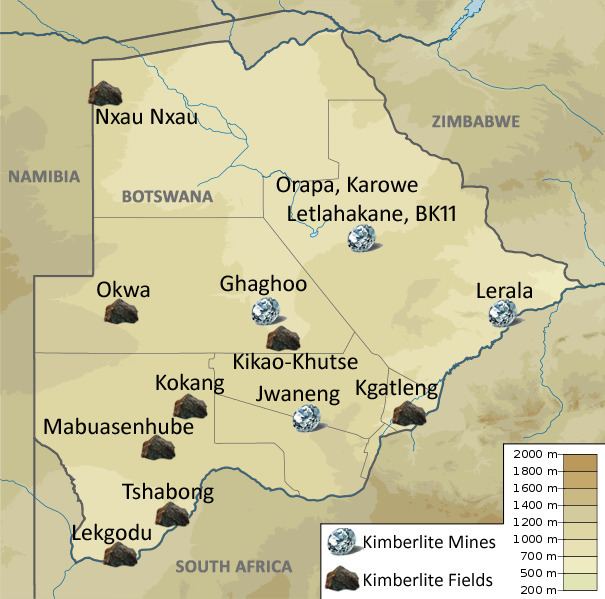Cut Raw Mine of origin Karowe Mine | ||
 | ||
Weight 1,111 carats (222.2 g; 7.14 ozt) Dimensions 65 mm × 56 mm × 40 mm (2.6 in × 2.2 in × 1.6 in) Colour Colourless/white, type IIa | ||
Lesedi La Rona, formerly known in media as Karowe AK6 or as Quad 1 by the personnel at the mine, is the third-largest diamond ever found, and the second-largest of gem quality. Only the non-gem black Sergio and the gem-quality Cullinan are larger. It was found in the Karowe mine, (formerly called AK6) in Botswana on 16 November 2015.
Contents
Description
The Lesedi La Rona is a colourless/white, type IIa diamond. It weighs 1,111 carats (222.2 g; 7.84 oz) and measures 65 mm × 56 mm × 40 mm (2.6 in × 2.2 in × 1.6 in). In comparison, the Cullinan, discovered in 1905 in South Africa, weighed 3,106.75 carats (621.350 g). The Lesedi La Rona was mined using Large Diamond Recovery ("LDR") XRT machines, and is the largest diamond recovered using machines for automated diamond sorting. It is estimated to be over 2.5 billion years old.
It was found on 16 November 2015, in the South Lobe of the Karowe mine about 200 m (660 ft) below the surface, and the find was announced on 18 November. A day after the discovery, two more diamonds weighing 813 and 374 carats (162.6 and 74.8 g) were found in the mine. Since the AK6 pipe was opened 18 months earlier, it has yielded over 1,000,000 carats (200 kg) of diamonds.
The stone was too big for the company's scanners.
Name
The diamond was first given a generic name after the mine (Karowe) and the pipe (AK6) where it was found. On 18 January 2016, Chief Executive Officer William Lamb of Lucara Diamond announced a competition, open to all Botswana citizens, to name the stone. In addition to naming the diamond the winner would receive P25,000 (about $2,170).
On 9 February 2016, Lucara Diamond announced that the stone had been named Lesedi La Rona which means "Our Light" in the Tswana language. The winner of the competition who named the diamond was Thembani Moitlhobogi from Mmadikola. He stated that his reason for the name was that "the diamond is a pride, light and hope of Batswana". During the competition Lucara Diamond Corporation received 11,000 emails and 1,000 SMSs with name suggestions.
History
The diamond was found in the south lobe of Canadian company Lucara Diamond's Karowe Mine about 500 km (310 mi) north of Gaborone in Botswana. The mine is located in the Letlhakane region, where three other diamond-producing kimberlite fields have mines named Orapa, Letlhakane and Damtshaa, with the Debswana Diamond Company Ltd. The first diamond from the mine was retrieved in 2012. Botswana, South Africa, and Namibia are the world's three top producers of mined diamonds.
In the months after its discovery the diamond was exhibited in a world tour in Singapore, Hong Kong, New York, and Antwerp, Belgium, a major centre of the world diamond trade.
Value and first auction
The exact value of the stone cannot be determined until it is decided how it will be cut and more details about its colour are known. Former diamond-mining geologist Phil Swinfen estimates, based on other similar sales, that the stone could be sold for $40–60 million. The process of selling and cutting the diamond "will likely take years to complete". In May 2016, Sotheby's in London announced that the Lesedi La Rona diamond would be offered in a stand-alone auction on 29 June 2016. It was expected to sell for around $70 million. After closer examination, the diamond was presented at the auction as weighing 1,109 carats.
At a public auction at Sotheby's on 29 June 2016, the highest bid for the diamond was $61 million. However, this bid fell short of the undisclosed reserve price and the stone was not sold. The bidding opened at $50 million and the sell lasted for less than 15 minutes. Lukas Lundin, whose family is Lucara Diamond’s largest shareholder, noted that the commission arrangement with Sotheby’s meant the stone would have had to reach $150 million for the auctioneer to make a large profit. “Up to $100 million,” Lundin said, “they make almost nothing.” According to David Bennett of Sotheby's, it was the first time the company held an exclusive auction for one single object. It was preceded by the sale of three smaller rough diamonds. The stones were also from Lucara and the proceeds, $140,000, were donated to charity. The bid was even lower than the $63.3 million that was paid for Lucara's Constellation, the 813 carat rough diamond auctioned in May 2016. The Constellation had been found the day after the Lesedi La Rona in the same section of the mine. After the failed sale, the Lucara stock fell on the Toronto Stock Exchange. The diamond will probably be sold privately.
In June 2016, Lesedi La Rona was insured for $120 million.
Technology
The diamond was recovered by a TOMRA large diamond recovery (LDR) machine utilizing X-ray transmission sensors. In May 2015, the operation at the Karowe Diamond Mine replaced their Dense Media Separation (DMS) technology with six TOMRA XRT sorters for sorting material in the -60+8 mm size range. The X-ray transmission (XRT) sorting technology was selected following a suite of tests. Each sorter can sort up to 150 metric tons (330,000 lb) of material per hour, after that the concentrate goes directly to hand sorting. Karowe Diamond Mine is the first mine using this automated diamond sorting solution.
